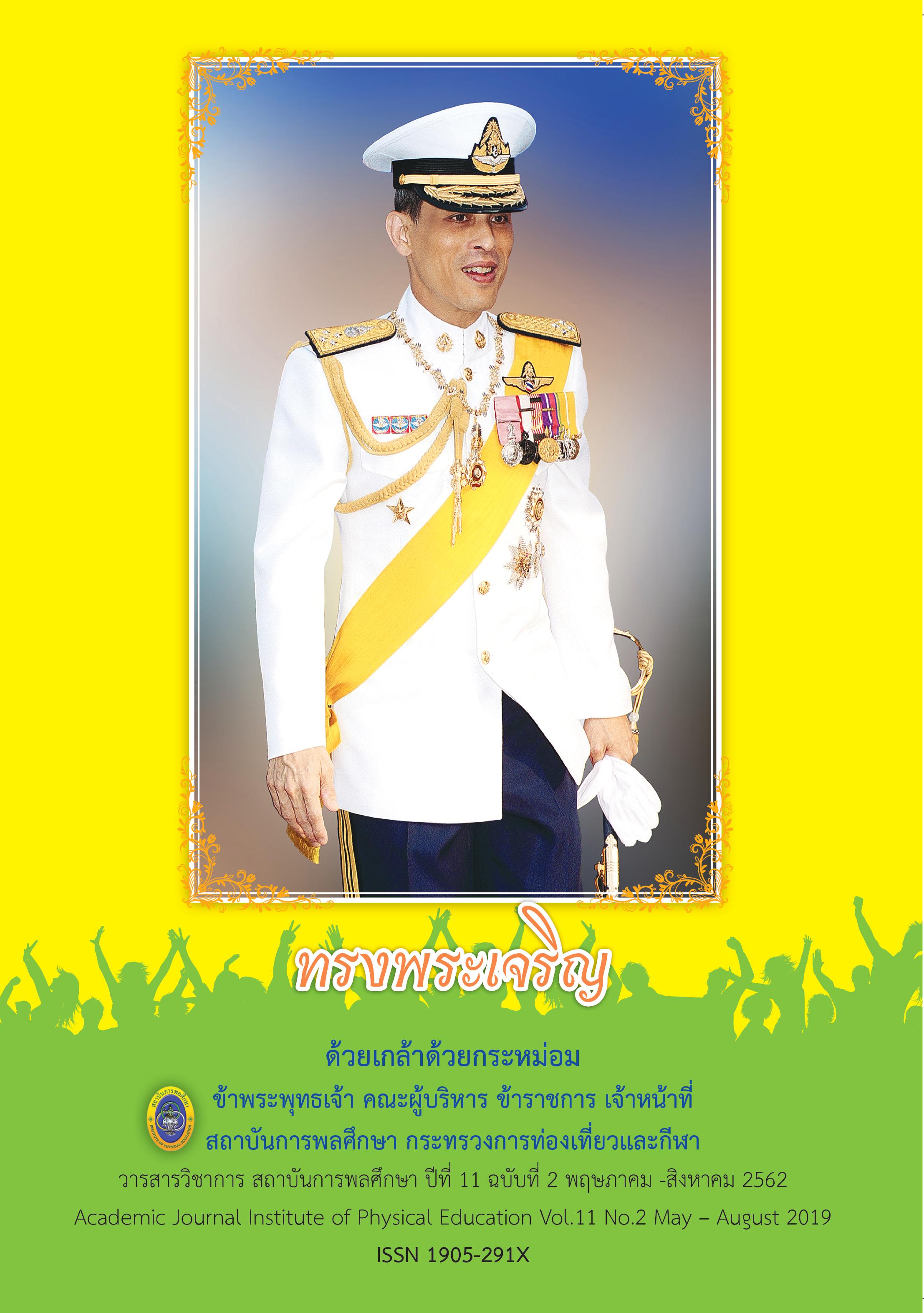TEACHING MEDIA ASSISTED PHYSICAL EDUCATION: TENNIS SHOOTER
Main Article Content
Abstract
The purposes of this invention were: 1) to create the tennis shooter for tennis class and contribute the learner tennis’s skill, 2) to invent the tennis shooter with many functional purposes: remote control, angle adjustable, fix or random ball feeding, three tennis ball speed levels, 3) investigate electronic supply by battery with 12 hr. capacity and convenient to move around tennis court. The results of invented tennis shooter were as followed:
1. The average of tennis balls feeding were 15 balls per minute.
2. The programs of ball feeding to left or right court were random and manual modes.
3. The programs of ball feeding speeds were slow, medium and high (30, 50, 70 km/hr., respectively).
4. Angle adjustable (up-down) range was from 55.9-78º.
5. The average distance of feeding balls were 6, 13, and 17 meter
6. There was highly accuracy of ball feeding to target area: short ball at 92 %, middle court at 95%, and 94% at baseline.
Article Details
The published article is a copyright of the Academic Journal of Thailand National Sports University. The passage appeared in each article in this academic journal is a perspective of each author which is not related to the journal. Each author is required to be responsible for all components of his/her own article. If there are any mistakes, each author must be responsible for those mistakes on his/her own.
References
Amporn Kunchornrat, Phairat Vongyuthakrai and Ophas Sookwan (2011). Design and build a tennis ball shooting machine. J Ind Edu, 5(2): 121-127. [in thai].
Arttachai Indrachumnum and Ongkharak Tummasaro (2008). Tennis shooter. Srivichai University of Technology. Retrieved September 23, 2017, from https://www.youtube.com/watch?v= Lm7PUrdzvTM. [in thai].
Football Thai factory sporting goods Co., Ltd. (2015). Tennis shooter. Retrieved September 15, 2015, from http://fbtsports.com/th/store/detail.php. [in thai].
Karussanu, M, & Glyn C. R. (1996). Motivation in Physical Activity Contexts: The Relationship of Perceived Motivational Climate to Intrinsic Motivation and Self-Efficacy. J Sport & Exerc Psycho, 18(3): 264-280.
Koson Rodma (2014). Strategic of Sport Center for Excellence in Institute of Physical Education. Academic Journal Institute of Physical Education, 6(2): 139-150. [in thai].
Manop Khonganithi (2010). Tennis shooter. Division of Mechanical Engineering, Department of Engineering, King Mongkut’s University of Technology North Bangkok. [in thai].
Nutthakan Champadae and Chinoso Visitnitikija (2016). Service quality of sports authority of Thailand, JGS SSRU, 9(2): 88-94. [in thai].
Richard Bailey (2005). Evaluating the relationship between physical education, sport and social inclusion, Educational Review, 57(1), 71-90.
Suebsai Boonveerabut (1998). Sports psychology. Chonburi printing, Chonburi. [in thai].
Suparoek Manjaiton (1997). Tennis. Chulalongkorn publishing, Pathumwan, Bangkok. [in thai].
Supranee Kwanboonchan (1996). Sports psychology. Bangkok: Thaiwatanapanich, Co.,Ltd. [in thai].
Surachai Bupha (2015). Sports innovation: tennis shooter. Retrieved September 24, 2017, from http://sod-surachai.blogspot.com/2012/01/blog-post.html. [in thai].
The International Tennis Federation (1997). Rules of Tennis. Printed by Wilton, Wright & Son Ltd, Massachusetts.
The lawn tennis association of Thailand under his majesty’s patronage (1992). Rules of tennis. Duplicating document, Bangkok. [in thai].
Victoria A. Goodyear & Ashley Casey (2015). Innovation with change: developing a community of practice to help teachers move beyond the ‘honeymoon’ of pedagogical renovation, PHYS EDUC SPORT PEDA, 20(2), 186-203.
Wasana Kunaapisit. (1998). Physical education curriculum. Bangkok: Promote academic center. [in thai].
Wayne Usher, Allan Edwards & Bianca de Meyrick (2015). Utilizing educational theoretical models to support effective physical education pedagogy. Cogent Education: 2(1): 109-117.


